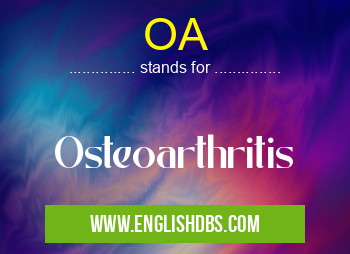What does OA mean in REHABILITATION
Osteoarthritis (OA) is a common joint disorder characterized by damage to the cartilage between joints, resulting in pain and stiffness. OA is usually seen in older adults but can affect people of any age. It is caused by age-related wear and tear on the body's joints, trauma to the joint, or a condition that puts extra stress on certain joints. OA can affect any joint in the body, but it most commonly affects hands, knees, hips and spine.

OA meaning in Rehabilitation in Medical
OA mostly used in an acronym Rehabilitation in Category Medical that means Osteoarthritis
Shorthand: OA,
Full Form: Osteoarthritis
For more information of "Osteoarthritis", see the section below.
Symptoms
The most common symptom of OA is pain after activity. People may also experience swelling around their joints as well as a lowered range of motion. Other symptoms may include muscle weakness or aches, stiffness and tenderness around the affected area. As the condition progresses, there may be bony enlargements on the fingers or palms known as Heberden's nodes and Bouchard's nodes.
Treatment
Treatment for osteoarthritis will depend on its severity and which joint is affected. In mild cases, doctors typically recommend lifestyle changes such as weight loss and exercise to slow down cartilage breakdown. Non-steroidal anti-inflammatory drugs (NSAIDs) may also be prescribed to reduce pain and inflammation. Severe cases may require surgery such as joint replacement or arthroscopy where a long thin camera is used to examine and treat damaged tissue inside the joint capsule.
Essential Questions and Answers on Osteoarthritis in "MEDICAL»REHABILITATION"
What is Osteoarthritis?
Osteoarthritis (OA) is a form of arthritis caused by the wearing away of the protective layer of cartilage that cushions the ends of bones in a joint. Over time, this can lead to pain, swelling, and difficulty moving the joint.
What are some common symptoms of Osteoarthritis?
Common symptoms associated with Osteoarthritis include pain, stiffness, swelling, cracking or popping noises in the joints when moving, reduced range of motion in the affected area, and an increase in joint tenderness upon pressure.
Who is most likely to develop Osteoarthritis?
While anyone can be affected by Osteoarthritis, the condition tends to be more common in people over age 40. People who are obese or have certain occupations that involve repetitive movements may be at a higher risk for developing Osteoarthritis as well.
What treatments are available for Osteoarthritis?
There are many treatments available for helping manage pain and other symptoms associated with Osteoarthritis including medication, physical therapy, lifestyle changes such as weight loss and exercise, heat/cold therapy, stress reduction activities such as yoga or tai chi and assistive devices like canes or braces.
Is there a cure for Osteoarthritis?
Unfortunately there is no cure for Osteoarthritis at this time; however there are treatments available that can help alleviate pain and other symptoms associated with the condition.
Are there any home remedies I can use when dealing with osteoarthritis?
There are several home remedies you can use to help ease discomfort since there is no cure for osteoarthritis. These include taking hot or cold baths/showers; using massage oils; applying heat/cold compresses on sore areas; stretching regularly; eating anti-inflammatory foods such as fish high in Omega-3 fatty acids; drinking plenty of water; avoiding nightshades; exercising regularly; maintaining good posture; and taking up relaxation exercises such as Yoga or Tai Chi.
Are certain activities bad for someone with osteoarthrtis?
Certain activities may be difficult for someone suffering from osteoaerthritis due to lack of flexibility and increased joint pain from repetitive motion. Activities such heavy lifting should generally be avoided due to potential strain on joints and low impact exercise that involves stretching should always done under medical supervision as it could cause further damage if not done properly.
Final Words:
OA is a common condition that can cause pain and stiffness of the joints due to age-related wear and tear or injury to them over time. Treatment depends on how severe it is but may include lifestyle changes, medication such as NSAIDs or more aggressive treatments like surgery when necessary. It's important to consult with your doctor if you think you might have OA in order to determine what treatment plan best suits your individual needs.
OA also stands for: |
|
| All stands for OA |
